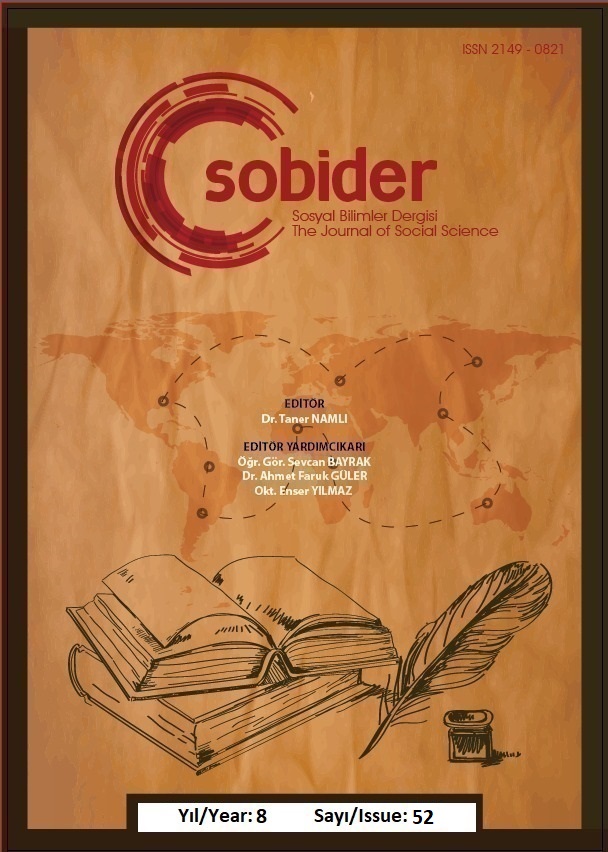Author :
Abstract
Hepimizin bildiği üzere devir artık tüketim devridir. Yiyeceği/giyeceği nasıl ki ihtiyaç dahilinde almıyor, adeta tüketmek için yarışıyorsak kültür ve sanatta da bu aşamaya ne yazık ki geldik. Uzun yıllardır kültür adamlarının “kültür endüstrisi, kültür tüketimi” gibi isimlerle adlandırdığı bu süreç artık hızla yayılıyor. Çağdaş sanat fuarları, bienal ve galerilerin geldiği noktaya bakınca bu süreç ve sanatı tüketme hızımız da açıkça görülmektedir. Uzun yıllar görmezden gelinen sanat, şimdi özellikle gençlerin olmazsa olmazı durumuna gelmiştir. Sanatın, aslında en genel anlamda özünde yer alan karşı koymak ve muhalefet duygusu sanatseverlere de sirayet etmiştir. Dolayısıyla da “sanatsever” yerine “sanat tüketicisi” tabirini kullanmak yanlış bir terim olmayacaktır. Estetik algısı, haz alma duyusu olmadan tanımlayamadıkları bir heyecan ile ilerliyorlar. Tam manasıyla “serbest bölge” olan sanat alanında sanatçı istediği malzemeden, istediği eseri üretir, istediği mesajı da verir. Sanat izleyicisinin o mesajı nasıl yorumladığı, eserde ne görmek, eserden ne almak istediği kendisine kalmıştır. Sanatçı eserini üretirken sanat izleyicisi ile bağ kurmak isterse bunu zaten yapıyor, eğer istemezse kimsenin eleştirme şansı yoktur. Bununla birlikte, sanatsal ürünlerin tüketiminin belirli bir yönü daha fazla ilgiyi hak ediyor. Sanat tüketiminde insan sermayesi girdisinin ağır etkisidir. Sanat alanında edinilen kültürel yeterlilik, sanat davranışının hem sıklığını hem de kalitesini etkiler. Yeterlilik gerekliliği, sanatın işlevi ve bir sosyal ayrım aracı olarak sanat tüketimi ile de ilgilidir.
Keywords
Abstract
As we all know, the era is now the era of consumption. Unfortunately, we have reached this stage in culture and art, just as we do not buy food/clothing as needed, but compete to consume it. For many years, this process, which has been named as "culture industry, cultural consumption" by the people of culture, is now spreading rapidly. When we look at the point that contemporary art fairs, biennials and galleries have come to, this process and the speed of consuming art can be clearly seen. Contemporary art, which has been ignored for many years, has now become a must for young people. The feeling of opposition and opposition, which is at the core of art, in fact, in the most general sense, has also spread to art lovers. Therefore, it would not be a wrong term to use the term "art consumer" instead of "art lover". They move forward with an excitement that they cannot describe without their aesthetic perception and sense of pleasure. In the field of art, which is literally a "free zone", the artist produces the work he wants from the material he wants, and gives the message he wants. How the art audience interprets that message, what they want to see in the work and what they want to get from the work is up to them. If the artist wants to connect with the art audience while producing his work, he already does it, if not, no one has a chance to criticize it. However, a certain aspect of the consumption of artistic products deserves more attention. It is the heavy impact of human capital input on art consumption. Cultural competence in the arts affects both the frequency and quality of artistic behavior. The competence requirement is also related to the function of art and the consumption of art as a means of social distinction.
Keywords
- Barthes, R. (1977). The death of the author. In Image-music text, Glasgow: Fontana.
- Barthes, R. (1977). The death of the author. In Image-music text, Glasgow: Fontana.
- Becker, G. (1965). A theory of the allocation of time. The Economic Journal 53, 493-517 Benjamin, W. (1972). Illuminations. London: Cape.
- Berger, J. (1972). Ways of seeing. London: Penguin.
- Bourdieu, P. (1985). Sosiologian kysymyksiä (Questions de sociologie). Tampere: Vastapaino.
- Douglas, M. (1981). High culture and low. Times Literary Supplement 13 (February), 163-164.Eskola, A. (1963). Jäykkyys ja taidekäsitykset (Rigidity and art judgements), University of Tampere Series.
- Eskola, K. (1976). Kulttuurin käytön esteet (Hindrances to the use of cultural products and services). Pääkaupunkiseudun julkaisusarja 1976. C3.
- Gasamer, H-G. (1975). Truth and method. London: Sheed & Ward.
- Giddens, A. (1976). New Rules of sociological method. London: Hutchinson.
- Hirschman, E. (1983). Aesthetics, ideologies and the limits of the marketing concept. Journal of Marketing (Summer), 45-55.
- Kantanen, T. (1984). Kuvataidepalvelun kulutus Vaasassa (Consumption of pictorial art in Vaasa). Unpublished master thesis. University of Vaasa.
- Lejonhielm, C. (1967). Colours, forms and art. Stockholm.
- Mason, R. (1981). Conspicuous consumption. Hampshire: Gower.
- Roos, J-P. (1985). Pelin säännöt: intellektuellit, luokat ja kieli (Rules of game: intellectuals,classes and language). Foreword to Bourdieu's Questions de sociologie, Finnish edition, 7-28.
- Seen, A. (1982). Choice, welfare and measurement. Oxford: Basil Blackwell. Uusitalo, L.(1979). Consumption style and way of life. Helsinki School of Economics Series A:27.
- Uusitalo, L. (1984). The symbolic dynamics of TV-viewing. Helsinki School of Economics. Working paper F:107.
- Uusitalo, L. (2008). ON THE CONSUMPTION OF PICTORIAL ART. L. Uusitalo içinde,Museum and visual art markets (s. 143-145). Helsinki, Finland: Helsinki School of Economics.
- Wolff, J. (1981). The social production of art. London: Macmillan. Görsel Kaynakça
- Görsel 1: Yıldırım, H. U. (2017, Kasım 7). Sanatı Nasıl Tüketiyoruz? 4 Haziran 2021 tarihinde Arsız Sanat: https://arsizsanat.com/sanati-nasil-tuketiyoruz/ adresinden alındı.
- Görsel 2: Uusitalo, L. (2008). ON THE CONSUMPTION OF PICTORIAL ART. L. Uusitaloiçinde, Museum and visual art markets (s. 143-145). Helsinki, Finland: Helsinki School of Economics.





